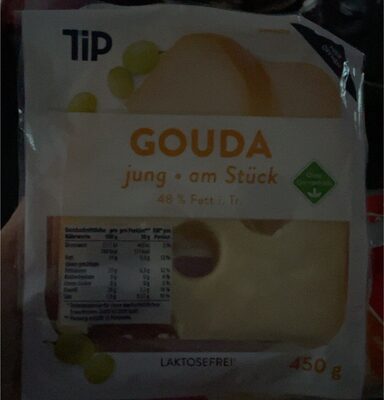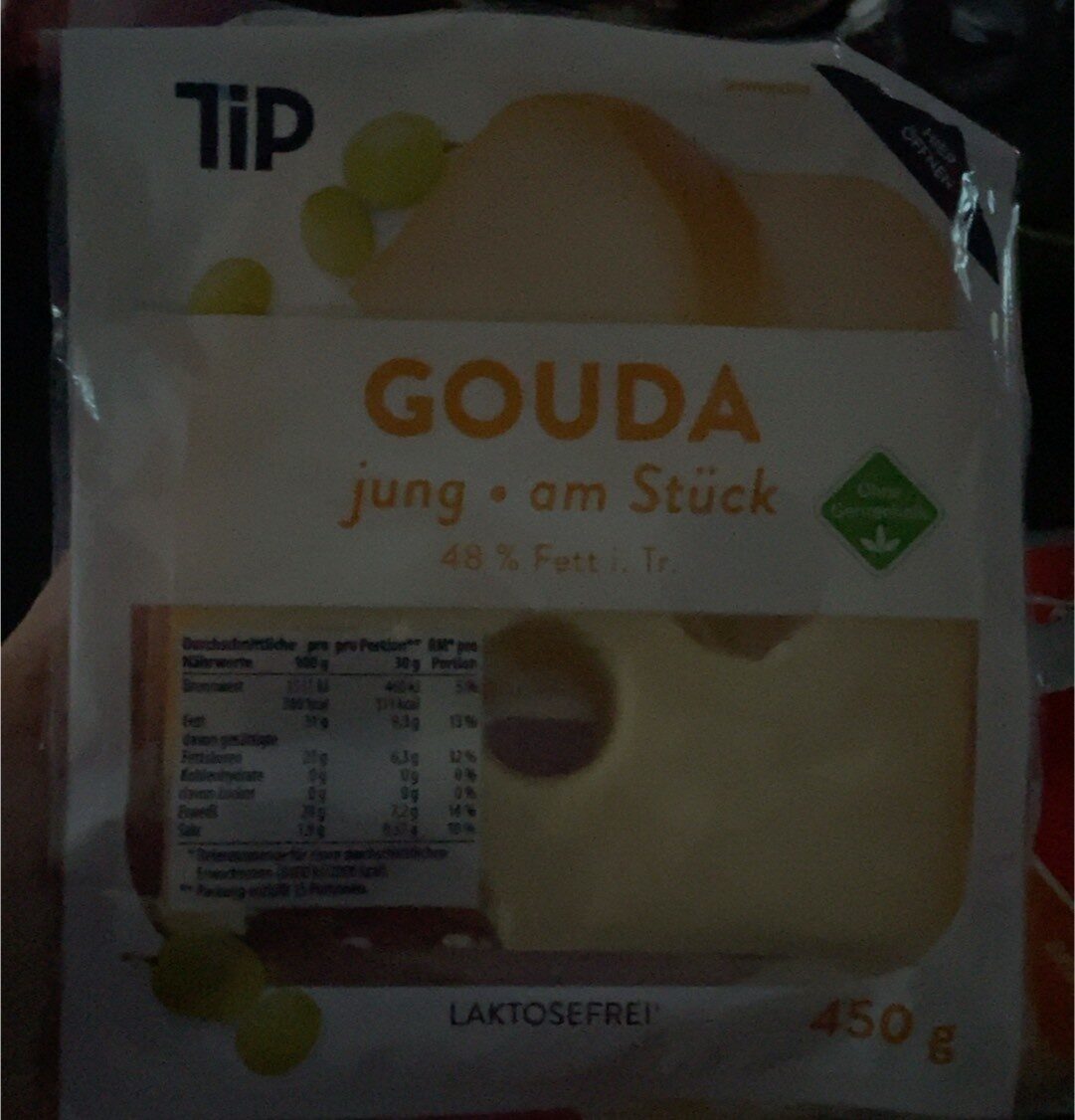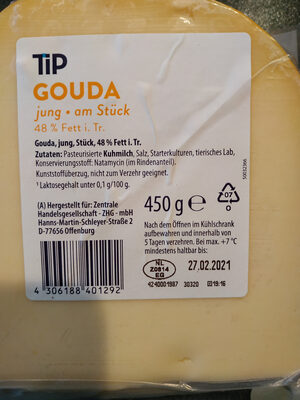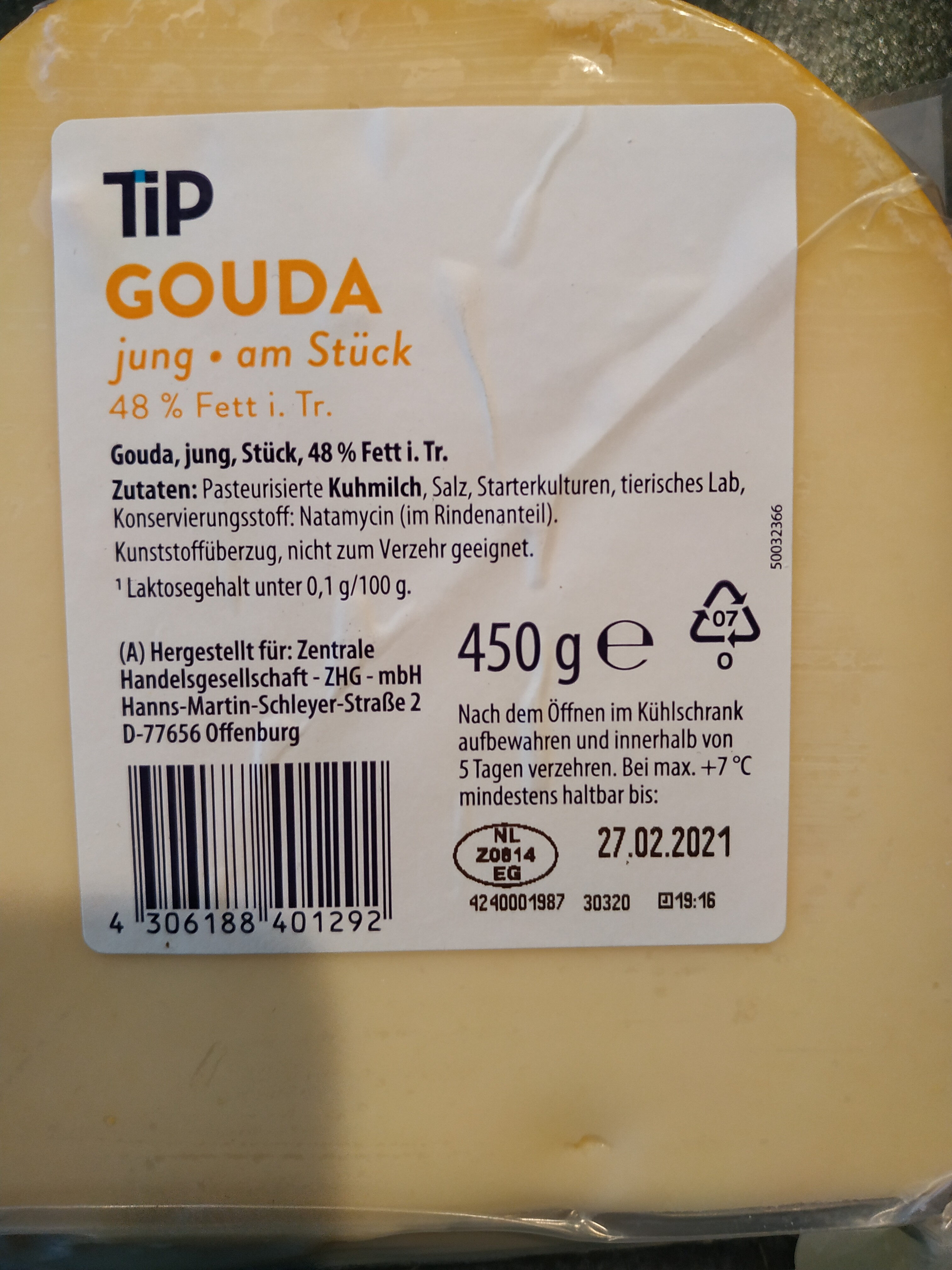Help us make food transparency the norm!
As a non-profit organization, we depend on your donations to continue informing consumers around the world about what they eat.
The food revolution starts with you!
Gouda - TIP - 450g
Gouda - TIP - 450g
This product page is not complete. You can help to complete it by editing it and adding more data from the photos we have, or by taking more photos using the app for Android or iPhone/iPad. Thank you!
×
Barcode: 4306188401292 (EAN / EAN-13)
Quantity: 450g
Packaging: Plastic
Brands: TIP
Categories: Dairies, Fermented foods, Fermented milk products, Cheeses, Cheeses of the Netherlands
Labels, certifications, awards:
No GMOs, Ohne Gentechnik
Manufacturing or processing places: Niederlande
Traceability code: NL Z0814 EG
Countries where sold: Germany
Matching with your preferences
Health
Ingredients
-
18 ingredients
German: Pasteurisierte Kuhmilch, Salz, Starterkulturen, tierisches Lab, Konservierungsstoff: Natamycin (im Rindenanteil). Kunststoffüberzug, nicht zum Verzehr geeignet. 1 Laktosegehalt unter 0,1 g/100 g. 07 (A) Hergestellt für: Zentrale Handelsgesellschaft - ZHG - mbH Hanns-Martin-Schleyer-Straße 2 D-77656 Offenburg 450 g E Nach dem Öffnen im Kühlschrank aufbewahren und innerhalb von 5 Tagen verzehren. Bei max. +7 °CAllergens: Milk
Food processing
-
Food processing level unknown
Food products are classified into 4 groups according to their degree of processing:
- Unprocessed or minimally processed foods
- Processed culinary ingredients
- Processed foods
- Ultra processed foods
The determination of the group is based on the category of the product and on the ingredients it contains.
Additives
-
E235 - Natamycin
Natamycin: Natamycin, also known as pimaricin, is an antifungal medication used to treat fungal infections around the eye. This includes infections of the eyelids, conjunctiva, and cornea. It is used as eyedrops. Natamycin is also used in the food industry as a preservative.Allergic reactions may occur. It is unclear if medical use during pregnancy or breastfeeding is safe. It is in the macrolide and polyene families of medications. It results in fungal death by altering the cell membrane.Natamycin was discovered in 1955 and approved for medical use in the United States in 1978. It is on the World Health Organization's List of Essential Medicines, the most effective and safe medicines needed in a health system. The wholesale cost in the developing world is between US$92.90 and 126.72 per 5-ml bottle as of 2015. It is produced by fermentation of the bacterium Streptomyces natalensis.Source: Wikipedia
Ingredients analysis
-
Palm oil content unknown
Unrecognized ingredients: de:im-rindenanteil, de:kunststoffüberzug, de:nicht-zum-verzehr-geeignet, de:1-laktosegehalt-unter, de:07, de:a, de:hergestellt-für, de:zentrale-handelsgesellschaft, de:zhg, de:mbh-hanns-martin-schleyer-straße-2-d-77656-offenburg-450-g-e-nach-dem-öffnen-im-kühlschrank-aufbewahren-und-innerhalb-von-5-tagen-verzehren, de:bei-max, de:7-cSome ingredients could not be recognized.
We need your help!
You can help us recognize more ingredients and better analyze the list of ingredients for this product and others:
- Edit this product page to correct spelling mistakes in the ingredients list, and/or to remove ingredients in other languages and sentences that are not related to the ingredients.
- Add new entries, synonyms or translations to our multilingual lists of ingredients, ingredient processing methods, and labels.
If you would like to help, join the #ingredients channel on our Slack discussion space and/or learn about ingredients analysis on our wiki. Thank you!
-
Non-vegan
Non-vegan ingredients: Pasteurised cow's milk, Animal-based rennetSome ingredients could not be recognized.
We need your help!
You can help us recognize more ingredients and better analyze the list of ingredients for this product and others:
- Edit this product page to correct spelling mistakes in the ingredients list, and/or to remove ingredients in other languages and sentences that are not related to the ingredients.
- Add new entries, synonyms or translations to our multilingual lists of ingredients, ingredient processing methods, and labels.
If you would like to help, join the #ingredients channel on our Slack discussion space and/or learn about ingredients analysis on our wiki. Thank you!
-
Non-vegetarian
Non-vegetarian ingredients: Animal-based rennetSome ingredients could not be recognized.
We need your help!
You can help us recognize more ingredients and better analyze the list of ingredients for this product and others:
- Edit this product page to correct spelling mistakes in the ingredients list, and/or to remove ingredients in other languages and sentences that are not related to the ingredients.
- Add new entries, synonyms or translations to our multilingual lists of ingredients, ingredient processing methods, and labels.
If you would like to help, join the #ingredients channel on our Slack discussion space and/or learn about ingredients analysis on our wiki. Thank you!
-
Details of the analysis of the ingredients
We need your help!
Some ingredients could not be recognized.
We need your help!
You can help us recognize more ingredients and better analyze the list of ingredients for this product and others:
- Edit this product page to correct spelling mistakes in the ingredients list, and/or to remove ingredients in other languages and sentences that are not related to the ingredients.
- Add new entries, synonyms or translations to our multilingual lists of ingredients, ingredient processing methods, and labels.
If you would like to help, join the #ingredients channel on our Slack discussion space and/or learn about ingredients analysis on our wiki. Thank you!
de: Pasteurisierte Kuhmilch, Salz, Starterkulturen, tierisches Lab, Konservierungsstoff (Natamycin (im Rindenanteil), Kunststoffüberzug), nicht zum Verzehr geeignet, 1 Laktosegehalt unter 0.1%, 07 (A), Hergestellt für (Zentrale Handelsgesellschaft), ZHG, mbH Hanns-Martin-Schleyer-Straße 2 D-77656 Offenburg 450 g E Nach dem Öffnen im Kühlschrank aufbewahren und innerhalb von 5 Tagen verzehren, Bei max, +7 °C- Pasteurisierte Kuhmilch -> en:pasteurised-cow-s-milk - vegan: no - vegetarian: yes - ciqual_proxy_food_code: 19051 - percent_min: 89.8 - percent_max: 99.4
- Salz -> en:salt - vegan: yes - vegetarian: yes - ciqual_food_code: 11058 - percent_min: 0.1 - percent_max: 1.9
- Starterkulturen -> en:lactic-ferments - vegan: maybe - vegetarian: yes - percent_min: 0.1 - percent_max: 1.9
- tierisches Lab -> en:animal-based-rennet - vegan: no - vegetarian: no - percent_min: 0.1 - percent_max: 1.9
- Konservierungsstoff -> en:preservative - percent_min: 0.1 - percent_max: 1.9
- Natamycin -> en:e235 - vegan: yes - vegetarian: yes - percent_min: 0 - percent_max: 1.9
- im Rindenanteil -> de:im-rindenanteil - percent_min: 0 - percent_max: 1.9
- Kunststoffüberzug -> de:kunststoffüberzug - percent_min: 0 - percent_max: 0.95
- Natamycin -> en:e235 - vegan: yes - vegetarian: yes - percent_min: 0 - percent_max: 1.9
- nicht zum Verzehr geeignet -> de:nicht-zum-verzehr-geeignet - percent_min: 0.1 - percent_max: 1.9
- 1 Laktosegehalt unter -> de:1-laktosegehalt-unter - percent_min: 0.1 - percent: 0.1 - percent_max: 0.1
- 07 -> de:07 - percent_min: 0 - percent_max: 0.1
- A -> de:a - percent_min: 0 - percent_max: 0.1
- Hergestellt für -> de:hergestellt-für - percent_min: 0 - percent_max: 0.1
- Zentrale Handelsgesellschaft -> de:zentrale-handelsgesellschaft - percent_min: 0 - percent_max: 0.1
- ZHG -> de:zhg - percent_min: 0 - percent_max: 0.1
- mbH Hanns-Martin-Schleyer-Straße 2 D-77656 Offenburg 450 g E Nach dem Öffnen im Kühlschrank aufbewahren und innerhalb von 5 Tagen verzehren -> de:mbh-hanns-martin-schleyer-straße-2-d-77656-offenburg-450-g-e-nach-dem-öffnen-im-kühlschrank-aufbewahren-und-innerhalb-von-5-tagen-verzehren - percent_min: 0 - percent_max: 0.1
- Bei max -> de:bei-max - percent_min: 0 - percent_max: 0.1
- +7 °C -> de:7-c - percent_min: 0 - percent_max: 0.1
Nutrition
-
Poor nutritional quality
⚠ ️Warning: the amount of fiber is not specified, their possible positive contribution to the grade could not be taken into account.⚠ ️Warning: the amount of fruits, vegetables and nuts is not specified on the label, it was estimated from the list of ingredients: 0This product is not considered a beverage for the calculation of the Nutri-Score.
Positive points: 5
- Proteins: 5 / 5 (value: 24, rounded value: 24)
- Fiber: 0 / 5 (value: 0, rounded value: 0)
- Fruits, vegetables, nuts, and colza/walnut/olive oils: 0 / 5 (value: 0, rounded value: 0)
Negative points: 22
- Energy: 4 / 10 (value: 1544, rounded value: 1544)
- Sugars: 0 / 10 (value: 0, rounded value: 0)
- Saturated fat: 10 / 10 (value: 21, rounded value: 21)
- Sodium: 8 / 10 (value: 760, rounded value: 760)
The points for proteins are counted because the product is in the cheeses category.
Nutritional score: (22 - 5)
Nutri-Score:
-
Nutrient levels
-
Fat in high quantity (31%)
What you need to know- A high consumption of fat, especially saturated fats, can raise cholesterol, which increases the risk of heart diseases.
Recommendation: Limit the consumption of fat and saturated fat- Choose products with lower fat and saturated fat content.
-
Saturated fat in high quantity (21%)
What you need to know- A high consumption of fat, especially saturated fats, can raise cholesterol, which increases the risk of heart diseases.
Recommendation: Limit the consumption of fat and saturated fat- Choose products with lower fat and saturated fat content.
-
Sugars in low quantity (0%)
What you need to know- A high consumption of sugar can cause weight gain and tooth decay. It also augments the risk of type 2 diabetes and cardio-vascular diseases.
Recommendation: Limit the consumption of sugar and sugary drinks- Sugary drinks (such as sodas, fruit beverages, and fruit juices and nectars) should be limited as much as possible (no more than 1 glass a day).
- Choose products with lower sugar content and reduce the consumption of products with added sugars.
-
Salt in high quantity (1.9%)
What you need to know- A high consumption of salt (or sodium) can cause raised blood pressure, which can increase the risk of heart disease and stroke.
- Many people who have high blood pressure do not know it, as there are often no symptoms.
- Most people consume too much salt (on average 9 to 12 grams per day), around twice the recommended maximum level of intake.
Recommendation: Limit the consumption of salt and salted food- Reduce the quantity of salt used when cooking, and don't salt again at the table.
- Limit the consumption of salty snacks and choose products with lower salt content.
-
-
Nutrition facts
Nutrition facts As sold
for 100 g / 100 mlCompared to: Cheeses of the Netherlands Energy 1,544 kj
(369 kcal)+4% Fat 31 g +10% Saturated fat 21 g +10% Carbohydrates 0 g -100% Sugars 0 g -100% Fiber ? Proteins 24 g -3% Salt 1.9 g +6% Fruits‚ vegetables‚ nuts and rapeseed‚ walnut and olive oils (estimate from ingredients list analysis) 0 %
Environment
-
Eco-Score D - High environmental impact
⚠ ️Select a country in order to include the full impact of transportation.The Eco-Score is an experimental score that summarizes the environmental impacts of food products.→ The Eco-Score was initially developped for France and it is being extended to other European countries. The Eco-Score formula is subject to change as it is regularly improved to make it more precise and better suited to each country.Life cycle analysis
-
Average impact of products of the same category: C (Score: 54/100)
Category: Camembert cheese, from cow's milk
Category: Camembert cheese, from cow's milk
- PEF environmental score: 0.50 (the lower the score, the lower the impact)
- including impact on climate change: 5.24 kg CO2 eq/kg of product
Stage Impact Agriculture
84.4 %Processing
5.6 %Packaging
4.4 %Transportation
3.3 %Distribution
1.8 %Consumption
0.5 %
Bonuses and maluses
-
Missing origins of ingredients information
Malus: -5
⚠ ️ The origins of the ingredients of this product are not indicated.
If they are indicated on the packaging, you can modify the product sheet and add them.
If you are the manufacturer of this product, you can send us the information with our free platform for producers.
-
Packaging with a medium impact
Malus: -10
Shape Material Recycling Impact Unknown Plastic High ⚠ ️ The information about the packaging of this product is not sufficiently precise (exact shapes and materials of all components of the packaging).⚠ ️ For a more precise calculation of the Eco-Score, you can modify the product page and add them.
If you are the manufacturer of this product, you can send us the information with our free platform for producers.
Eco-Score for this product
-
Impact for this product: D (Score: 39/100)
Product: Gouda - TIP - 450g
Life cycle analysis score: 54
Sum of bonuses and maluses: -15
Final score: 39/100
-
Carbon footprint
-
Equal to driving 2.7 km in a petrol car
524 g CO² per 100g of product
The carbon emission figure comes from ADEME's Agribalyse database, for the category: Camembert cheese, from cow's milk (Source: ADEME Agribalyse Database)
Stage Impact Agriculture
85.1 %Processing
5.0 %Packaging
5.0 %Transportation
4.0 %Distribution
0.7 %Consumption
0.1 %
Packaging
-
Packaging with a medium impact
-
Packaging parts
(Plastic)
-
Packaging materials
Material % Packaging weight Packaging weight per 100 g of product Plastic
-
Transportation
-
Origins of ingredients
Missing origins of ingredients information
⚠ ️ The origins of the ingredients of this product are not indicated.
If they are indicated on the packaging, you can modify the product sheet and add them.
If you are the manufacturer of this product, you can send us the information with our free platform for producers.Add the origins of ingredients for this product Add the origins of ingredients for this product
Report a problem
-
Incomplete or incorrect information?
Category, labels, ingredients, allergens, nutritional information, photos etc.
If the information does not match the information on the packaging, please complete or correct it. Open Food Facts is a collaborative database, and every contribution is useful for all.
Data sources
Product added on by openfoodfacts-contributors
Last edit of product page on by bartolomeu.
Product page also edited by kiliweb, off.d71bfda4-c804-4c27-b2c4-097806a9533d, packbot, roboto-app, yuka.sY2b0xO6T85zoF3NwEKvlkxMcMjjnC7FNDrtyEet2_vTJcDXQd5txKP_bao.










